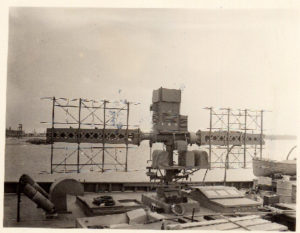The History of InfoAge Science & History Museums
World War II & Radar - Radar experts worked at Camp Evans to protect canalRadar experts worked at Camp Evans to protect canal

Army radar on the M.S. Nordic protecting the Panama Canal in 1942 [above] was designed at Camp Evans.
By Fred Carl
The fires were still burning at Pearl Harbor when the reality of the problem was realized. How can the Panama Canal be protected from a sneak attack? The Japanese had achieved complete surprise even though they were detected by radar 50 minutes before the first bomb fell.
All the Japanese or Germans had to do was destroy a few ships in the canal locks and the Allies would have to ship troops and supplies around South America. The strategic shipping route would be cut, possibly for months. This would give the German U-boats more time to sink Allied ships.
The Army had positioned radar units from Fort Monmouth at both ends of the canal but more protection was needed. The decision was made to place Army radar on picket ships to give the canal over 200 miles of radar protection. The U.S. Army was determined to prevent another surprise attack which could result in the canal being damaged or destroyed.
A team of 20 engineers headed by Dr. John Marchetti began work on the problem. They worked 15-hour days, six to seven days a week. They had to modify the radar to use new transmitter tubes developed by Dr. Harold Zahl. These tubes required 20,000 volts to send radar pulses 100 miles.
In a few weeks, the development was complete. The improved radar was ready to be tested at sea. The M.S. Nordic was docked at Belmar, just across the Shark River basin from Camp Evans. The new radar was installed under guard and in secret. During tests at sea, the Nordic was always escorted by a blimp or destroyer to protect the lightly armed ship from U-Boat attacks.
By 1943, the picket ships were no longer necessary. The Navy had secured the approaches to the canal. Dr. Zahl recounted in Electrons Away that Marchetti and his team would further improve the special purpose radar. It would find other uses on land and sea. The radar was given the code name AN/TPS-3. The Zenith Company would produce 900 of the units. They would be used in the failed invasion of Arnhem in 1944, in all theaters of war and 25 would be used on D-Day to protect the beaches from air attacks.
Dr. Marchetti was given the Order of the British Empire and decorated by France for his radar contributions. He visited Camp Evans in 1999. He shared another AN/TPS-3 story that is documented in the official Signal Corps History of WWII. – a story for another day.
[Fred Carl is the director of the Infoage Science-History Center at Camp Evans.]
page created August 30, 2003
We Need Your Help! Volunteer with Us.
Join our mission to preserve historic Camp Evans and teach the public about science and history.
Sign up to join our team of volunteers and start on your own mission today.
InfoAge Science & History Museums
2201 Marconi Road
Wall, NJ 07719
Tel: 732-280-3000
info@infoage.org
webmaster@infoage.org


